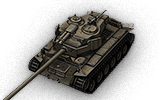Select your region to log in.
T26E4 SuperPershing
Crew:
- Commander
- Radio Operator
- Driver
- Gunner
- Loader
Advantages:
- Strong frontal armor profile, good protection against HEAT/HE shells due to spaced armor
- Great gun depression
- Good penetration for a tier VIII American tank.
- Preferential matchmaking (will never see Tier 10 battles)
- Good credit maker, low repair cost and cheap ammunition
Disadvantages:
- Only the front of the tank is well-protected, sides and rear are exposed and vulnerable
- Very weak engine power and bad ground resistance, sluggish mobility
- Very poor gun handling for a medium tank
- Having multiple frontal weakspots, especially the cupola and cheeks, disqualifies this tank as heavily armored.
- Playstyle is very different compared to regular American medium tanks
Tank description:
The T26E4 SuperPershing is an American tier 8 premium medium tank.To increase firepower, a new long-barrelled 90-mm gun was mounted on the T26E1 in January 1945. The prototype was designated the T26E4. Development was discontinued in January 1947 due to problems with the gun and the loading mechanism. A total of 25 vehicles had been built by that time, but never entered service.The T26E4 "Super Pershing" is a M26 Pershing with upgraded protection in the form of spaced armor scrapped off from one of the Panther tanks. It is analagous to the M4A3E2 Sherman Jumbo in that it is the up-armored variant of a mobile medium. The T26E4 does not however have access to the upgraded engine or the long 90mm of the M26 (although as of 9.17, AP penetration is similar to each other), but does have the similar but historically-accurate long 90mm tested on the tank. The turret face of the T26E4 has very good durability to complement the tough frontal hull. This makes it nearly impervious to HE shells from the front, and allows it to hold positions or assault them reasonably well. The armor, while very tough, is not completely immune to gunfire. The T26E4 has three large weakpoints: the turret cheeks under the "ears" formed by the additional armor welded on, the commander''s hatch and the long viewing port on the right side of the hull. Shots entering here will penetrate and deal damage. However, these weakpoints are covered up nicely when hull-down on a reverse slope. The T26E4 is very slow for a medium tank and is especially vulnerable while climbing hills or when it has found itself to have been flanked. It may be advisable to use the oil consumable now and then. While it is claimed to eat HEAT shells, it is an complete lie as tanks that has about 330mm+ of HEAT pen can reliably penetrate the upper hull arrmor and the lower hull armor reliably - such as the T-54''s HEAT Rounds and the M103''s HEAT rounds. This, coupled with the T26E4''s sluggish turret traverse, means it will often be easily flanked, where its much thinner side and rear armor can be engaged. Likewise, this means the Super Pershing will not be able to flank most opponents, forcing you to fight enemies head-on but at a reasonable range where it will be more difficult for them to aim at the Super Pershing''s weak spots. The T15E1 gun has average accuracy, and lacks in alpha and DPM to face most heavy tanks. When playing the Super Pershing, great care must be taken to aim for the weakpoints on enemy armor and to keep the three weak spots hidden or constantly moving. Overall, the T26E5 is a better choice in everything but camouflage values.
To increase firepower, a new long-barrelled 90-mm gun was mounted on the T26E1 in January 1945. The prototype was designated the T26E4. Development was discontinued in January 1947 due to problems with the gun and the loading mechanism. A total of 25 vehicles had been built by that time, but never entered service.

 Русский
Русский English
English Russian region
Russian region North-american region
North-american region European region
European region Asia region
Asia region Korean region
Korean region


 0
0
 7 200
7 200